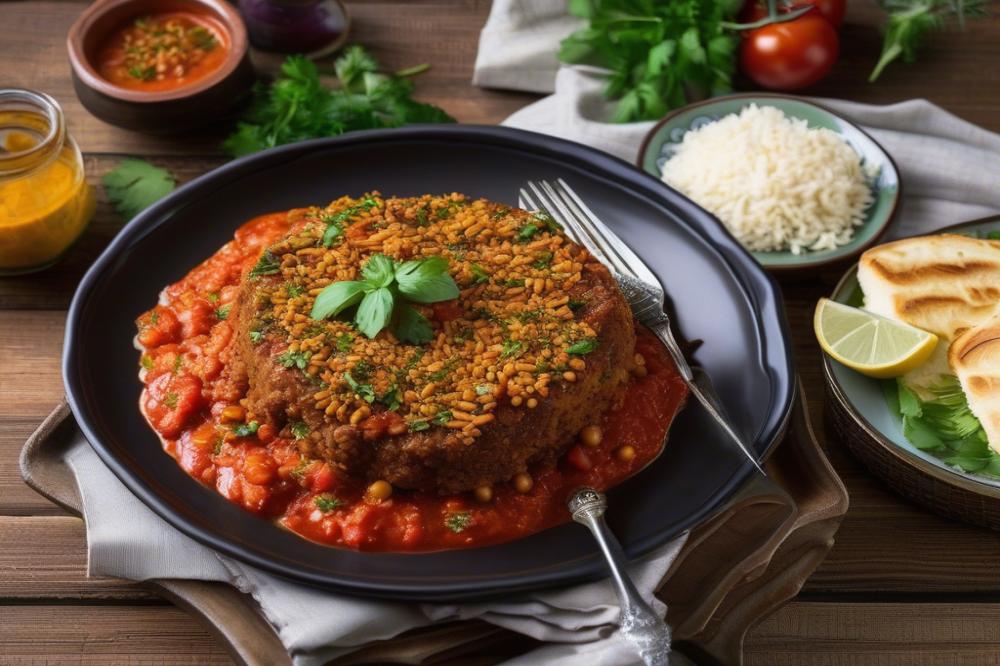Introduction to Moroccan Cuisine
Moroccan cuisine is a delightful blend of flavors and traditions. It draws influence from various cultures, including Arab, Berber, and Mediterranean. The food often features aromatic spices that create rich, complex tastes. From savory dishes to sweet desserts, each meal tells a story of the land and its people.
Dried Fruits like apricots, raisins, and almonds play a significant role in traditional cooking. These ingredients not only add sweetness but also bring nutrition to the table. They are often used in various recipes, enhancing both the flavor and texture of meals. Incorporating Dried Fruits into cooking can transform a simple dish into an experience.
One of the most popular ways to enjoy these rich ingredients is through a Moroccan Tagine. This slow-cooked stew is typically made in a special earthenware pot. It harmonizes flavors beautifully, allowing spices and dried fruits to complement each other. The result is a unique dish with layers of taste. Preparing Moroccan meals with these ingredients offers a chance to explore healthy meals while enjoying the vibrant essence of Moroccan culture.
Moroccan Tagine: Ingredients and Cooking Method

Ingredients List with Quantities
Gather the following items to create a delicious Moroccan tagine:
- 1 kg lamb or chicken
- 200 g dried apricots
- 100 g raisins
- 150 g toasted almonds
- 2 onions, chopped
- 4 cloves garlic, minced
- 2 tsp ground cinnamon
- 1 tsp ground ginger
- 1 tsp cumin
- 1 tsp coriander
- 500 ml chicken or vegetable broth
- Olive oil for cooking
- Salt and pepper to taste
Cooking Instructions
Start by preparing all the ingredients. Chop the onions and mince the garlic. Pour a splash of olive oil into a large pot and heat it over medium flame. Add the onions and garlic, sautéing them until they soften and the aroma fills the kitchen.
Now, it’s time to add the spices. Sprinkle in the cinnamon, ginger, cumin, and coriander. Stir these flavorful spices into the onions and garlic for about a minute. The heat will help release their wonderful scents.
Next, add the lamb or chicken, ensuring each piece is coated with the spice mixture. Brown the meat lightly on all sides. Doing this step adds depth to the dish.
Now, pour in your broth. Include the dried apricots and raisins at this stage. Stir everything together, then season with salt and pepper to taste. The sweetness from the dried fruits will balance the savory elements beautifully.
Cover the pot and reduce the heat to low. Let it simmer for about 1.5 to 2 hours. This cooking time allows the flavors to meld together. If you’re using chicken, it might cook faster, so check for doneness earlier.
As you wait, toast the almonds in a dry pan until golden brown. This step adds a nice crunch to your dish. When ready to serve, sprinkle these almonds over the stew for garnish.
Consider adding fresh herbs like coriander or parsley for an extra burst of freshness. This helps elevate the dish’s presentation and flavor. By following these instructions for traditional cooking, you will create a delightful meal inspired by Moroccan cuisine.
Health Benefits of Dried Fruits

Dried fruits such as apricots, raisins, and almonds are not only delicious but also packed with nutrients. They offer various vitamins and minerals that contribute to better health. Apricots, for example, are rich in vitamin A and potassium. This combination supports eye health and helps regulate blood pressure. Raisins are another great choice. They provide iron and calcium, essential minerals for blood health and bone strength. Almonds, while often considered nuts, are technically seeds. They are an outstanding source of vitamin E and magnesium.
Antioxidants play a crucial role in the health benefits of dried fruits. This group of compounds helps combat oxidative stress in the body. Dried apricots contain carotenoids, which are known to support skin health. Raisins have phenolic compounds that aid in reducing inflammation. Almonds, too, are rich in antioxidants, lending additional protective effects on heart health. Including these dried fruits in your meals can significantly enhance their nutritional value.
Incorporating dried fruits into recipes can lead to healthy meals with outstanding flavors. Their natural sweetness complements the savory dishes often found in Moroccan cuisine. Cooking with apricots and raisins adds a wonderful depth to tagine recipes. The balance between spices and sweetness harmonizes beautifully, creating dishes that are both comforting and nutritious. Almonds provide a satisfying crunch, making meals more interesting and enjoyable.
Utilizing these dried fruits also offers a convenient way to add variety to your diet. They can be tossed into salads, blended into smoothies, or used as toppings for yogurt. The versatility of these ingredients makes them perfect for traditional cooking or modern twists on classic meals. Exploring different combinations helps discover what flavors work best together.
Exploring Moroccan Spices

Overview of Spices Commonly Used in Moroccan Cuisine
Moroccan cuisine is rich with flavors. Spices play a crucial role in this vibrant culinary tradition. Commonly used spices include cumin, coriander, cinnamon, and saffron. Each one brings its own characteristics to food. Cumin has a warm, earthy taste, while cinnamon adds a sweet and aromatic touch. Saffron, known for its golden hue, lends a subtle bitterness. Together, these spices create an aromatic blend that enhances savory dishes and highlights the natural sweetness of dried fruits.
How Spices Interact with Dried Fruits to Create Complex Flavors
The interplay of spices and dried fruits elevates each dish. Dried apricots and raisins complement the warmth of cinnamon and the zest of ginger. When used in recipes, these fruits absorb the flavors of the spices. This absorption forms a delightful contrast between sweet and savory. Each bite offers a complex layering of tastes. The result is a culinary experience that is both satisfying and intriguing. Dishes become not just meals, but celebrations of flavor.
The Role of Spices in Traditional Cooking and Savory Dishes
Spices have an important place in traditional cooking. They transform simple ingredients into delicious meals. In Moroccan tagines, spices create depth and enhance the overall dining experience. Savory dishes, such as those featuring tender meats and vegetables, benefit immensely from this spice combination. Healthy meals become more enticing with the rich flavors spices offer. Almonds, often included in Moroccan recipes, add a crunch that contrasts beautifully with the softness of dried fruits. This combination results in a meal full of texture and taste.
Variations and Modern Twists on the Tagine
Alternative Ingredients
When cooking with dried fruits, you can explore a variety of options. Instead of just apricots, consider using figs or dates. Both add rich sweetness to savory dishes. Raisins also work well, offering a chewy texture. Don’t overlook the use of prunes; they can contribute both sweetness and depth. Pair dried fruits with a medley of fresh vegetables. Carrots, bell peppers, and zucchini blend beautifully in a tagine. Each ingredient adds its own flavor and texture, enriching the overall meal.
Creative Adaptations
For a contemporary twist on classic recipes, think outside the box. You might try using couscous instead of traditional grains. This change provides a light and fluffy base for your dish. Consider adding spices like cinnamon or cumin for unexpected depth. Mint and cilantro can brighten up the flavors beautifully. Experiment with different nuts, such as pistachios or cashews, for added crunch. They offer a delightful contrast to the tenderness of cooked fruits. Incorporating these elements creates a new experience for your taste buds.
Catering to Dietary Preferences
Adjustments can easily make your recipes suitable for various dietary needs. For vegetarian options, focus on plant-based proteins like chickpeas or lentils. These ingredients provide substance and nutrition in healthy meals. Gluten-free substitutions, like quinoa or rice, will satisfy those avoiding wheat. Turning to seasonal vegetables keeps the dish fresh and vibrant. You can still maintain the spirit of Moroccan cuisine while adapting to modern preferences. Don’t shy away from inviting everyone to enjoy these flavorful meals.
Tasting the Wonders of Moroccan Cuisine
The beauty of Moroccan tagine stems from its vibrant flavors and rich traditions. This remarkable dish marries tender meats, earthy vegetables, and aromatic spices, creating a meal that transports your taste buds to a faraway land. The inclusion of dried fruits adds a delightful sweetness, enhancing savory notes in profound ways.
As you explore recipes inspired by Moroccan flavors, don’t hesitate to experiment with various dried fruits. Raisins, apricots, and figs can transform a simple dish into something extraordinary. Your kitchen can become a canvas for creativity, where each choice brings new depth to the meal. Fear not the unknown, for cooking is all about trying new things and discovering what excites your palate.
Incorporating Moroccan ingredients into your cooking routines allows for both indulgence and healthfulness. A tagine brings together diverse elements that nourish the body while pleasing the senses. Both flavor and nutrition harmonize, offering a unique satisfaction in every bite.
Ultimately, savoring Moroccan cuisine at home can be a fulfilling journey. Enjoy the process, share these meals with loved ones, and let each dish inspire not just nourishment, but connection. Embrace the adventure of flavor exploration, and let the tastes of Morocco enrich your culinary experiences.



